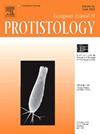Architecture of the flagellar apparatus and related structures in Kolkwitziella acuta: Towards a fine-structural characterization of pallium-feeding dinoflagellates (Protoperidiniaceae)
IF 1.9
2区 生物学
Q4 MICROBIOLOGY
引用次数: 0
Abstract
The fine-structural organization of the protoperidiniacean Kolkwitziella acuta was examined by SEM and TEM. Serial sections of five cells of K. acuta were used to study the architecture of basal bodies and associated roots, the pusular system, and the feeding apparatus. The basal bodies were inserted 1 µm apart at an angle of ca. 80°, and displayed the typical peridinioid features of associating with two roots each and having a layered connective linking the longitudinal microtubular root to the transverse striated root. The transverse flagellar canal was associated with a ‘sac pusule’, while the longitudinal flagellar canal was linked, via a pusule canal surrounded by a conspicuous layer of striated material, to a collecting chamber from which ca. 40 pusular tubes radiated. An extruded pallium was present, associated with a microtubular strand (the MSP) that extended anteriorly and progressively separated into six or seven groups of microtubules, with electron-opaque vesicles present along the MSP. A prominent striated collar surrounded the exit area of the pallium and was connected to the striated collars of both the transverse and longitudinal flagellar canals. The partial nuclear-encoded LSU rDNA sequence confirmed the identification as K. acuta. The currently known fine-structural features of pallium-feeding Protoperidiniaceae are summarized.
Kolkwitziella acuta 的鞭毛器及相关结构:对食藻类甲藻(原甲藻纲)进行精细结构鉴定。
利用扫描电子显微镜(SEM)和电子显微镜(TEM)研究了原尾柱虫Kolkwitziella acuta的精细结构组织。用五片 K. acuta 细胞的连续切片来研究基部体和相关根系、脓泡系统和摄食装置的结构。基质体以约 80° 的角度相距 1 µm 插入,并显示出典型的周细胞特征,即每个基质体与两个根相连,并有分层的结缔组织将纵向微管根与横向条纹根连接起来。横向鞭毛管与一个 "囊脓管 "相连,而纵向鞭毛管则通过脓管与一个收集室相连,收集室周围有一层明显的条状物质,从收集室中伸出约 40 根脓管。有一个挤压出的褶层,与向前方延伸的微管股(MSP)相连,并逐渐分离成 6 或 7 组微管,沿 MSP 有不透电子的囊泡。一个突出的条纹领环绕着褶皱出口区域,并与横向和纵向鞭毛管的条纹领相连。部分核编码的 LSU rDNA 序列证实了其为 K. acuta。本文总结了目前已知的以鳞片为食的原栉水母科(Protoperidiniaceae)的精细结构特征。
本文章由计算机程序翻译,如有差异,请以英文原文为准。
求助全文
约1分钟内获得全文
求助全文
来源期刊

European journal of protistology
生物-微生物学
CiteScore
4.60
自引率
20.70%
发文量
55
审稿时长
14.6 weeks
期刊介绍:
Articles deal with protists, unicellular organisms encountered free-living in various habitats or as parasites or used in basic research or applications. The European Journal of Protistology covers topics such as the structure and systematics of protists, their development, ecology, molecular biology and physiology. Beside publishing original articles the journal offers a forum for announcing scientific meetings. Reviews of recently published books are included as well. With its diversity of topics, the European Journal of Protistology is an essential source of information for every active protistologist and for biologists of various fields.
 求助内容:
求助内容: 应助结果提醒方式:
应助结果提醒方式:


